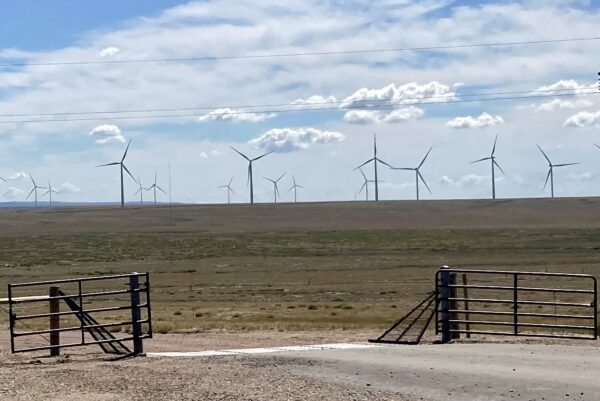Energy security concerns put focus on generating domestic energy to reduce reliance on imported fossil fuels
Russia’s war with Ukraine has many nations examining ways to shorten supply lines by generating more domestic energy, which will speed a global transition away from fossil fuels “to a more decarbonized system,” forecasts BP Chief Economist Spencer Dale.
“Right now, oil and gas are the most heavily imported sources of energy in the world,” he said, but the war has fostered “heightened concern over energy security,” which will “accelerate the nature of the energy transitions” to favor domestic generation, much of which “will likely be in non-fossil fuels, such as wind, solar, nuclear.”
Speaking at the Center for Strategic and International Studies (CSIS) in Washington on Feb, 23, Dale said BP’s annual 2023 Energy Outlook forecasts that oil and natural gas will continue to generate about 80 percent of the world’s energy through at least 2030.
That’s good short-term news for fossil fuel industries in the United States, the world’s largest oil and natural gas exporters, which are likely to see demand increase over the next decade, before BP forecasts declines by 2035 as domestic-sourced energies become more viable.
“The passing of the momentous Inflation Reduction Act (IRA) in the U.S.” in November 2021 is also spurring worldwide investments in renewables and nuclear power that within a decade will begin to elbow oil and natural gas out as primary electricity generators, he said.
BP forecasts a reduction in global fossil energy consumption from the present 80 percent in total power generation to anywhere from 28- to-55 percent by 2050.
Coal consumption will tail off even more dramatically in the coming decades, Dale said, but he predicts countries like China and India—which now import up to 85 percent of the oil and half the natural gas they need—may use coal because they have ample and affordable domestic supplies.
President Joe Biden in January said fossil fuels “won’t be needed in a decade.” While BP’s analysis indicates a potential decline in demand, it maintains oil and natural gas will remain key energy assets for the foreseeable future.

The ‘Energy Trilemma’
London-based BP is the world’s fourth-largest investor-owned oil company behind ExxonMobil, Shell, and TotalEnergies. Its BP America Division alone reported $164.2 billion in 2022 revenues.
The company’s operations range from exploration to retail in more than 80 countries. It owns nearly 19,000 service stations worldwide under its brand, but also as Amoco in the United States and Aral in Germany.
The projections and data included in BP’s annual Energy Outlook, published each year in January, include highly regarded indicators that are widely used in analyses by industry leaders, government planners, economists, financial institutions, and investors.
So, a lot of people across the globe were listening intently to Dale’s comments during his webcast with CSIS’s Director of Energy Security & Climate Change Joseph Majkut—including, most likely, House Republicans pushing a 17-bill package proposing to “unleash” America’s energy resources, especially oil and natural gas, which they maintain are unduly burdened by the IRA and other components of President Joe Biden’s “rush to green energy policies.”
The Energy Outlook appraises the security, affordability, and sustainability of the global “energy system” through three scenarios in meeting 2050 CO2 emissions standards in the 2050 Paris Accords.
“All of these scenarios will be wrong. We cannot predict the future. We don’t have a preferred scenario, a base scenario,” Dale said.
While those projections span a wide range of possible scenarios for the global energy system over the next 30 years, one thing the 2002 Energy Outlook didn’t calculate was Russia invading Ukraine in February 2022.
As a result, Dale said, “The world has changed,” elevating security and affordability evenly with sustainability to form “the energy trilemma.”
The invasion exposed that “we lost sight of the other two dimensions that a well-functioning energy system needs to provide, security and affordability,” Dale said. “In the context of any enduring, durable energy transition, it would need to take in all three of those dimensions. The big messages of the past year have reminded us of the importance of the other two components as we seek to decarbonize the world’s energy systems.”

Pendulum Shift to ’Net Zero’
The three dimensions are each weighed across three scenarios: “business as usual,” or current trends; “net zero,” or what would be required to meet 2050 Paris goals; and “War-Accelerated,” which would exceed those 2050 standards.
The war in Ukraine is “shifting the pendulum strongly from ‘business as usual’ toward ‘net-zero,’” Dale said, with “more fragmented markets” based on policies that “increase domestic resilience and less on International trade.”
One of the nuances in how energy policies are changing is before 2022, planners were “heavily focused on lowering the supply of hydrocarbons,” he said, adding now they must make similar efforts to ensure “demand falls in line with supply.”
This will “slow the pace of globalization” and demand for imported hydrocarbons, which may become less available anyway because Russia’s petrochemical industries—the world’s second-largest fossil fuels exporter, especially to Europe—will presumably have “limited access to western technology and finance,” meaning they are unlikely to improve in performance or efficiency.
CSIS’s Majkut said U.S. natural gas exports have “kept the lights on in Europe” since Russia’s invasion of Ukraine and noted there are calls to expand the pipelines and terminal infrastructure necessary for the U.S. producers to ship oil and natural gas overseas.
If Europe and other nations, citing the need for secure supply lines, eventually replace imported oil and natural gas from the United States, and overall use of renewable and nuclear energies increase, Majkut wondered if long-term investments in pipelines and terminals being pondered in Congress today will be tomorrow’s “stranded assets problem.”
Dale said it is better to be figuring out what to do with a “stranded asset” decades later than worry about being stranded now because you didn’t have that asset when it was useful.
He compared it to property insurance. “We have a decision about whether we want to pay our house insurance. By doing [paying insurance], we have to forego some consumption (spending). You have think of energy security as the same thing,” he said, calling investment in export infrastructure “a trade-off for a robust and resilient energy system” whose mere presence as an “assurance” propels innovation in others.
“Think about energy security the same way as house insurance but on a national level,” Dale said. “Some assets, it is really critical that they are there to provide assurance.”








